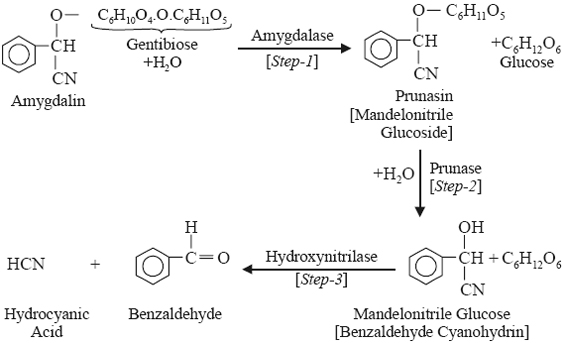2.6.1 Bitter Almond
Synonym Amygdala amara.
Table 4.5 Cyanogenetic Glycosides and Biological Source
Biological Source Bitter almond comprises of the dried ripe kernels of Prunus amygdalus Batsch. Var amara (DC) Focke; Prunus communis Arcang., P. amygdalus Bail; and Amygdalus communis Linn., belonging to family Rosaceae.
Geographical Source Bitter almond trees are mostly native of Persia and Asia Minor. They are also cultivated in the cooler parts of Panjab and Kashmir, Italy, Sicily, Portugal, Spain, Southern France and Morocco.
Description
Colour : Brown
Odour : No specific odour
Taste : Bitter
It is, however, assumed that the enzyme emulsin, isolated from the kernels of bitter almonds, comprises of several enzymes, such as: amygdalase, prumase, hydroxynitrilase etc.
Chemical Tests The general tests of the cyanogenetic glycosides by means of microchemical reactions in naturally occurring crude drugs are based on their hydrolysis to yield hydrocyanic acid. In fact, there are four speciifc and characteristic reactions to detect the presence of liberated HCN, namely:
1. Ferriferrocyanide Test: Macerate 1 g of the powdered drug with 5 ml of alcoholic KOH (5% w/v) for five minutes. Transfer it to an aqueous solution containing FeSO4(2.5 %w/v) and FeCl3 (1% w/v), and maintain at 60-70°C for 10 minutes. Now, transfer the contents to HCl (20%) when the appearance of a distinct prussian blue colour confirms the presence of HCN.
2. Precipitation of Hg from HgNO3: The reduction of aqueous mercurous nitrate solution (3% w/v) to metallic Hg by HCN being observed by an instant formation of black metallic Hg in the cells.
3. Grignard Reaction Test: First of all, dip a strip of white filter paper into a solution of picric acid (1 % w/v in water) drain and then dip into a solution of sodium carbonate (10% w/v in water) and drain. Now, place the crushed and moistened drug material in a small Erlenmeyer flask, and subsequently suspend the strip of the prepared sodium picrate paper above the material and stopper the flask with an air tight cork. Maintain the flask in a warm place for 1 hour when the liberated HCN would turn the sodium picrate paper from its original yellow colour to brick red colour due to the formation of sodium isopurpurate (Grignard’s Reaction).
4. Cuprocyanate Test: First of all, saturate pieces of filter paper in a freshly prepared solution of guaic resin dissolved in absolute ethanol and allow them to dry completely in air. Now, carefully moisten a piece of the above paper with a very dilute solution of CuSO4 and place it into contact with a freshly exposed surface of the drug. In case, HCN is generated, it will give rise to a distinct stain on the paper.
Uses
1. Bitter almonds are employed as sedative due to HCN content.
2. The fixed oil of bitter almond finds its use as demulscent in skin-lotion.
3. It is also employed in the preparation of amygdalin and bitter almond water.
Note
1. The misleading term Vitamin B17, has sometimes been applied to amygdalin.
2. Bitter almond oil must not be used for flavouring of foods and confectionaries.










